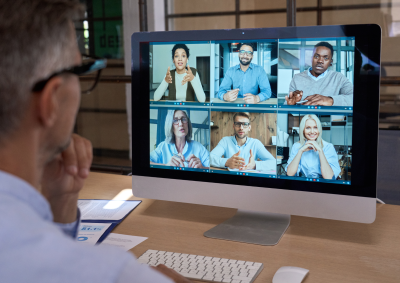Most Effective Ways To Develop Your Skills As A Leader In A Remote Environment
Embrace Technology for
Effective Communication
Cultivate Trust & Collaboration
in a Remote Setting
Set Clear
Goals & Expectations
Provide Regular
Feedback & Recognition
Continuously Learn & Adapt
in the Digital Landscape
Embrace Technology for Effective Communication
Embrace technology and watch as your leadership skills flourish in a remote environment, as virtual communication tools become your trusty companions in the digital landscape.
In today's world, where remote work is becoming increasingly common, effective communication is key to successful leadership. Technology offers a wide range of tools that can help bridge the physical gap between team members and enhance collaboration. Video conferencing platforms like Zoom and Microsoft Teams allow leaders to conduct virtual meetings with their team, fostering a sense of connection and ensuring everyone is on the same page. These tools also enable leaders to read non-verbal cues and facial expressions, which are essential for understanding team dynamics and addressing any concerns.
In addition to video conferencing, instant messaging platforms like Slack and Microsoft Teams provide a convenient way to communicate in real-time. These tools allow leaders to quickly share updates, assign tasks, and provide feedback, creating a sense of immediacy and keeping the team engaged. Document collaboration tools such as Google Docs and Microsoft Office 365 enable leaders to work collaboratively with their team on projects and documents, ensuring everyone has access to the latest version and can contribute seamlessly. By embracing technology, leaders can leverage these communication tools to effectively lead their remote teams, fostering a sense of connection, collaboration, and productivity.
Cultivate Trust and Collaboration in a Remote Setting
Foster trust and collaboration in a remote setting by actively engaging with your team members and building strong relationships based on open communication and shared goals.
In a remote environment, it can be challenging to establish trust and collaboration as there is limited face-to-face interaction. However, by utilizing various communication tools such as video conferences, instant messaging, and project management platforms, leaders can bridge the gap and create an environment of trust and collaboration. Regular check-ins, team meetings, and one-on-one conversations are essential to keep the lines of communication open and ensure that everyone feels heard and valued. By actively engaging with your team members, you can understand their strengths, weaknesses, and individual goals, which will help you assign tasks and delegate responsibilities more effectively.
Additionally, building strong relationships based on trust and open communication is crucial in a remote setting. Encourage your team members to share their ideas, concerns, and feedback openly. Actively listen to their input and acknowledge their contributions. Regularly provide updates on the overall progress of the team and celebrate individual and collective successes. By fostering an environment where everyone feels comfortable sharing their thoughts and opinions, you can encourage collaboration and improve the overall performance of the team. Building trust in a remote setting takes time, but by consistently demonstrating transparency, integrity, and empathy, leaders can cultivate an atmosphere of trust and collaboration, leading to increased productivity and success for the team as a whole.
Set Clear Goals and Expectations
Establish clear goals and expectations for your remote team by clearly communicating what needs to be achieved and outlining the specific tasks and timelines involved.
When working in a remote environment, it is crucial to provide your team with a clear roadmap to success. By setting clear goals, you ensure that everyone is aligned and working towards the same objectives. Clearly communicate what needs to be achieved and break down the goals into smaller, manageable tasks. This not only helps your team understand their responsibilities but also provides them with a sense of direction and purpose. Additionally, outlining specific timelines for each task helps to create a sense of urgency and keeps everyone accountable for their work.
Setting clear goals and expectations also helps to foster a sense of autonomy and ownership within your remote team. When team members know exactly what is expected of them, they can take ownership of their tasks and work independently to achieve the desired outcomes. This sense of autonomy can lead to increased motivation and productivity. Moreover, clear expectations provide a framework for evaluating performance and providing feedback. When goals and expectations are well-defined, it becomes easier to assess individual and team progress, identify areas for improvement, and provide constructive feedback. This feedback loop is essential for continuous growth and development as a remote team.
Provide Regular Feedback and Recognition
Create a culture of growth and recognition by consistently providing feedback and acknowledging the efforts of your remote team members. In a remote environment, it's crucial to establish clear channels of communication to ensure that feedback is delivered in a timely and constructive manner.
Regular check-ins, one-on-one meetings, and team meetings can provide opportunities for leaders to offer feedback on individual performance, project progress, and overall team dynamics. Whether it's positive feedback or constructive criticism, it's important to be specific and provide examples to help remote team members understand their strengths and areas for improvement. By doing so, leaders can help their team members feel valued and supported, which in turn fosters a sense of motivation and commitment to their work.
Recognition is another important aspect of developing skills as a leader in a remote environment. It's easy for remote team members to feel isolated and disconnected, especially when they don't have the opportunity for in-person interactions. Therefore, leaders should make an effort to recognize and celebrate the achievements of their remote team members. This can be done through public acknowledgments during team meetings, personalized messages of appreciation, or even small gestures like sending virtual gift cards or company swag. Recognizing the hard work and dedication of remote team members not only boosts morale but also creates a positive work culture where everyone feels valued and motivated to excel.

Continuously Learn and Adapt in the Digital Landscape
To excel as a leader in the ever-evolving digital landscape, you must constantly adapt and learn new strategies and technologies. The rapid advancements in technology have transformed the way businesses operate, requiring leaders to stay updated with the latest trends and tools.
One effective way to continuously learn and adapt is by engaging in online courses and webinars that focus on leadership in remote environments. These platforms provide valuable insights and resources to enhance your skills as a leader, covering topics such as virtual team management, communication techniques, and remote collaboration tools. By proactively seeking out these learning opportunities, you can stay ahead of the curve and effectively navigate the challenges of leading in a digital world.
In addition to formal learning, leaders should embrace a growth mindset and be open to experimentation and innovation. The digital landscape offers numerous opportunities to test and implement new strategies that can enhance team productivity and collaboration. Leaders can leverage project management tools, online communication platforms, and virtual team-building activities to create a positive remote work culture. It is crucial to encourage team members to share their ideas and suggestions for improvement, fostering a culture of continuous learning and adaptation. By embracing new technologies and exploring innovative approaches to leadership, you can effectively lead your team in a remote environment and drive success in the digital landscape.
Frequently Asked Questions
Effective Communication






